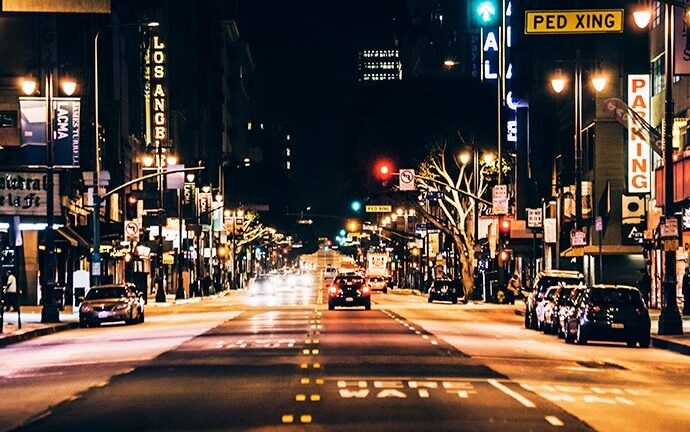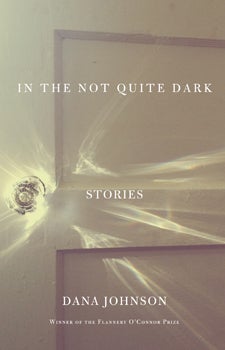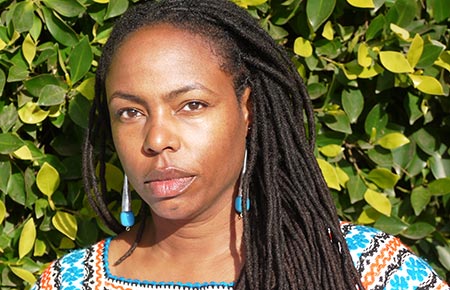
O, Pioneers: Dana Johnson explores the remaking of L.A.’s historic core
Here in Los Angeles, you learn early and often: Screen magic trumps real life.
Writer and professor Dana Johnson was reminded of that prickly coexistence on a recent afternoon. Wandering into Union Station, she found it a-swarm. Not teeming with commuting Bunker Hill suits nor the downtown Arts District’s new guard, but rather the entire lounge space swallowed up by a buzzing film crew: cables, lights, scrims and steel barricades. “You can sit,” a disembodied voice rebuffed all in approach, “but don’t move.”
She made a beeline, into the courtyards at the edges of the station. Stashed in a hidden corner, Johnson happened upon a small bronze plaque commemorating the terminal’s 50-year anniversary in 1989: “Through the portals of this historic edifice have passed the great and near-great.”
Johnson’s fiction has long examined those edges — animating the “near great”; the L.A. that isn’t in the foreground, the one that is too often asked to sit, but don’t move. That’s the L.A. she moves through every day on foot.
“I get a notion. An image. A line of dialogue,” she said. “Or maybe it’s just a feeling I want to explore.”
Her new collection, In the Not Quite Dark: Stories (Counterpoint Press), published last month, is a cycle of pieces that drifts through layers of L.A. histories — people’s history, yes; but, too, the city’s buildings and streets. After generations of erasure, the city’s grid becomes a palimpsest.

Johnson’s new short story collection, In the Not Quite Dark: Stories, is a cycle of pieces that drifts through layers of L.A. histories.
“Half the places I write about aren’t there anymore,” she said. “But what was there? What echoes? It’s a way to tell those stories that get lost,” she explained. She settled onto a bench in a quiet corner offering a view of travelers coming and going.
The author of three books — a novel, and two story collections — Johnson’s fiction strips away the surface story of Los Angeles. It’s the L.A. you see, hear, smell if you’re on foot, if you pause, if you let your window down and listen for it.
Not the telegenic Los Angeles
Poetic and, at turns, unflinchingly raw, the 11 stories explore a wide-ranging Los Angeles experience: People pulled from elsewhere seeking transformation; natives sprung up from L.A.’s soil carving out life around the noise. It considers that projected dream — the West as a site of transformation — but its inverse, too: What happens when you chase a dream that dissolves each time you reach out to capture it.
The L.A. that many of Johnson’s stories pull into focus is not the telegenic region of rolling lawns, beaches and opulence. Rather, it’s a series of backdrops and situations that most Angelenos move through daily — city dwellers overwhelmed by traffic, keeping one step ahead of gentrification, at turns bewildered and humbled by homelessness.
In the opening story, “Rogues,” Johnson tackles the not-often-told contemporary story of Southern California out-migration — the surge of people of color moving away from the city’s core to the far-flung suburbs to chase another dream, only to find themselves caught in a similar cycle — of gangs and crime.
Opposite that, “Because That’s Easier” follows a young family who uproot from their Valley digs to try their hand at loft living. The wife and mother, Frida, worries that “their kid is turning weird.” Refusing to venture outside. Wailing if her shoe soles hit any surface beyond the threshold of their loft. Frida’s worried that they aren’t fit for this “urban pioneer” living, which boils down to inhabiting a part of the city that has neither resolved the needs of its most desperate nor caught up with its developer’s dreams. “There was no getting around the cold hard facts,” Frida observes, “that so many people had nothing. Less than nothing.”
It’s this dissonance — $16 cocktails just steps from shantytowns — with which Johnson wanted wrestle. “It’s all this really horrific stuff I see daily that people inure themselves to. That’s what I wanted to look at.”
In the Not Quite Dark arrives at a critical moment in L.A.’s own story. As long-abandoned neighborhoods are re-inhabited, the city battles with the ramifications of a denser and more vertical city. How will that mark us?
Informed by personal experience

Associate Professor of English Dana Johnson.
Johnson’s stories have an urgent, real-time feel to them, as if you are eavesdropping on across-the-table intimacies or a street corner meltdown. The pitch of anger or depth of desire flies off the page. It’s a skill that she attributes to her reporter’s training.
“I majored in print journalism at USC with a minor in creative writing. So really capturing that rawness and not being sentimental is important to me,” she said.
Now an associate professor of English at USC, Johnson, an L.A. native, spent years drifting through different neighborhoods, absorbing atmospheres.
“I grew up on 80th and Vermont, but my dad moved us out to West Covina in the ’70s, hoping for something better for us all.”
She left Los Angeles in the mid ’90s for graduate school at the University of Indiana. While there, she won the Flannery O’Connor Award for short fiction for her first collection, Break Any Woman Down. Upon her return to L.A. in the early 2000s, she settled in Echo Park, just as that neighborhood was revving up to gentrify.
Her close read on present-day downtown L.A. is informed by personal experience. She was part of an early wave of tenants repopulating the long-vacant Historic Core. Life in a place that changes both haphazardly and dramatically has given her an up-close vantage on how expertly an old narrative can be worked like a sentence — rewritten or elided. People come and go, replace — or displace — one another; it’s about how we remember them. One story overtakes another; some have more weight.
The edges of L.A. history
“The Story of Biddy Mason” elegantly puzzles through that inequity. It’s a pairing of two migrant stories: That of railroad magnate Henry Huntington and the slave-cum-real estate entrepreneur and philanthropist, Biddy Mason, who walked herself West, from Mississippi and into freedom. Johnson wanted to examine elision, but she also wanted explore how we weight life narratives.
“While I wanted to look at the cracks in the myth of the ‘self-made man,’ I also I wanted to put those pioneer stories side by side,” said Johnson. “We know so much about Huntington — the library, the beach, the man oversaw the laying down of the Pacific Electric Rail, connecting all of Los Angeles, but what do we know of Biddy Mason?”
A black woman who was also part of building and nurturing a young L.A., Mason founded First African Methodist Episcopal Church. “I wanted to pull stories out of the shadows. Those stories that are often obfuscated or are ignored.”
With this collection, Johnson hopes to bring the edges of L.A.’s story to the center — not just the ghosts of the past but also those invisible souls, struggling and striving, who move through the streets with her downtown.
“People always think about that TV version that doesn’t allow for all of the different regions or how deeply diverse it is. I wanted to write about L.A. as it exists — in the here and now — before that moment is gone, too.”